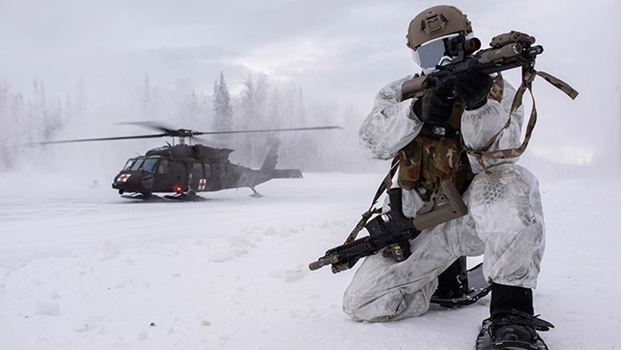
Sikorsky is offering S-70M Black Hawks for the UK’s New Medium Helicopter acquisition but has previously seen London reject Black Hawk offers (Lockheed Martin UK on Twitter)
BELFAST — After months of refusing to share production plans in support of a bid to secure the UK’s £1 billion ($1.15 billion) New Medium Helicopter contract, Sikorsky president said today the firm will provide such details once full requirements have been outlined to industry — including where the helos would be built.
Company president Paul Lemmo said the US manufacturer is also confident that it could meet an accelerated production timeline if the UK was to opt for one.
“Certainly we’re all waiting and watching to understand what the path forward is [for NMH] and that’s really the reason why we’re not being public about where we plan to produce the aircraft,” said Lemmo during a Thursday virtual media roundtable. “We have a plan for sure. We have industry partners that we’ve been in extensive dialogue with, throughout the UK, to support this program. And we really just want to see the final tender and understand what the requirements are going to look like before we make a public announcement on our approach, including the prosperity aspect of that acquisition.”
Sikorsky is pitching the S-70M Black Hawk for the acquisition, which was initially stood up to procure between 36 and 44 medium helicopters and replace Royal Air Force Puma HC2 aircraft as well as a number of niche rotary fleets including Bell 212, Bell 412 and AS365 Dauphins.
The competition’s two other entrants, Airbus and Leonardo, have already committed to production plans. If selected, Airbus said it will setup a H175M line in Broughton, Wales, where it currently makes wings for the A380 commercial airliner. Should Leonardo be awarded a production contract, it said it will produce AW149 helicopters from Yeovil, England.
Lockheed Martin, Sikorsky’s parent company, also owns Polish manufacturer PZL Mielec, which produces the S-70i export variant of the US Army’s UH-60 Black Hawk from Poland and could be used for the NMH.
“Without going into too much detail for competitive reasons, with a hot production line, there are certainly things that we can do to accelerate deliveries,” Lemmo said today. “Obviously, we’ll have to wait and see exactly how accelerated they have to be and whether we can meet their target but there are levers that we can pull to accelerate delivery.”
However, if Sikorsky was to offer NMH production outside the UK, the manufacturer runs a risk of not meeting British industrial strategy guidance. The strategy mainly focuses on military acquisitions prioritizing proposals that provide high levels of prosperity with contractors expected to demonstrate how their offers can stimulate UK economic growth. Alternatively, setting up a new UK helicopter production facility would greatly increase Sikorsky’s NMH prospects of success, but presumably at a higher cost of investment of money and time for the firm.
The UK could look to acquire new helicopters at pace largely because now the Puma fleet is set to retire in 2025, although this month it was revealed by Air Chief Marshal Richard Knighton, that the helo’s timeline could be extended to 2027 or 2028.
Industry has yet to be told by the UK MoD when a NMH production contract will be awarded, and there is currently no entry to service date for the aircraft. An invitation to negotiate (ITN) phase, set to define requirements and costs was scheduled for Q1 2023, but lawmaker Sarah Atherton said earlier this month that NMH tender documents are in the possession of an “assessment committee” which has to sign off on new approvals before ITN can begin.
Elsewhere during the briefing today, Lemmo said that Sikorsky expects to pitch the Sikorsky-made US Marine Corps’s new CH-53K heavy-lift helicopter for inclusion in a future Swiss rotary tender. The aircraft has already been sold to Israel, but Sikorsky has still to secure a European sale after losing out to Boeing’s CH-47 Chinook in Germany.
“In Europe, there was a [heavy-lift helicopter] requirement for the Swiss,” said Lemmo. “They pulled that off the table right now because of budgeting, but I expect that to come back around. It will be a relatively small number of aircraft, but that’s another country that we will be competing in eventually. I’d say right now there’s anywhere from three to five countries that we’re in an active discussion with.”
He clarified that the other countries are in the Asia-Pacific region but would not name individual customers.
Lockheed Martin projects potential $1 billion loss on classified program
Lockheed CFO Jay Malave said the company currently expects the program to become profitable on an annual basis around the 2028 timeframe.


























